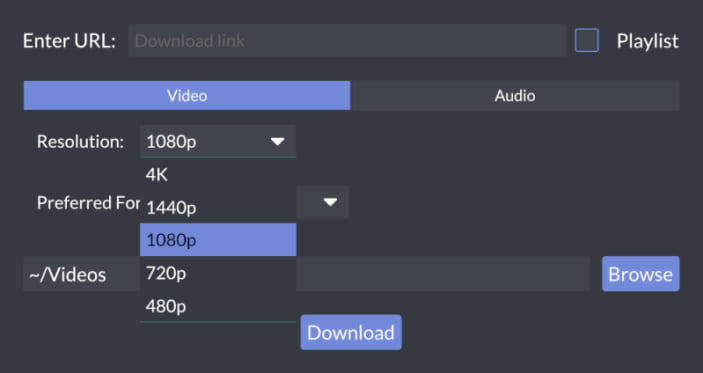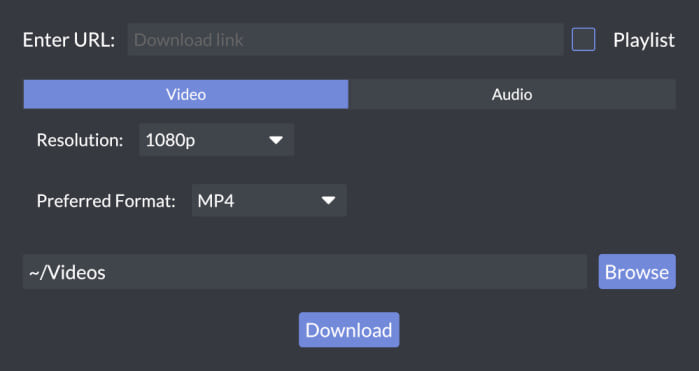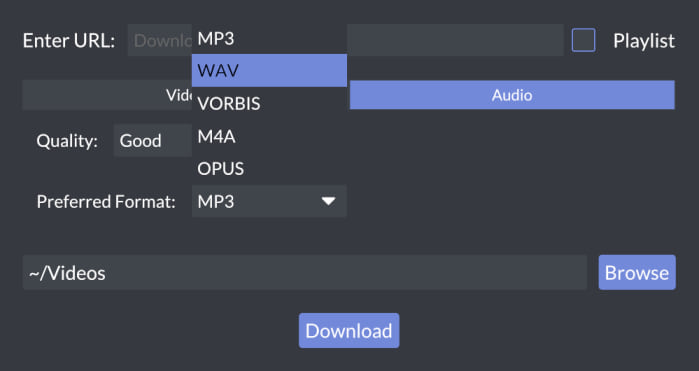3 releases (breaking)
| 0.3.0 | Aug 28, 2023 |
|---|---|
| 0.2.0 | Oct 25, 2022 |
| 0.1.0 | Oct 14, 2022 |
#375 in Operating systems
340KB
1.5K
SLoC
ytdlp-gui
a GUI for yt-dlp written in Rust
Preview


Installation
Linux
NixOS (Flake)
you can use the flake.nix in the repo
in your flake.nix:
{
inputs = {
nixpkgs.url = "github:nixos/nixpkgs/nixpkgs-unstable";
ytdlp-gui = {
url = "github:bksalman/ytdlp-gui";
};
};
outputs = { nixpkgs, ytdlp-gui, ...}:
let
system = "x86_64-linux";
pkgs = import nixpkgs {
inherit system;
overlays = [
ytdlp-gui.overlay
];
};
in
{
...snip
then you can add it as a normal package, either to your home-manager or nixosConfiguration
Fedora
download the rpm package from the releases page then install it with sudo dnf localinstall <rpm_package_name>
Ubuntu
download the deb package from the releases page then install it with sudo apt install ./<deb_package_name>
Arch
Available in the AUR ytdlp-gui
other distributions
1- download yt-dlp
either
a- from your distribution repo
b- or download the binary, then move it to your bin directory, and make it an executable by running chmod +x <bin_file>
2- download ffmpeg or ffmpeg-free from your distribution repos
3- download the ytdlp-gui binary from the realeases page
Windows
just download the zip (it's actually tar.gz for now) file from the releases page, extract it in a subfolder and start the ytdlp-gui.exe
Build from source
to build from source you need to have cargo and rustc, you can install them through rustup (rust toolchain manager), or from your distribution repos, whatever you like
after that run the following commands:
# clone the repository to "ytdlp-gui" folder
git clone https://github.com/BKSalman/ytdlp-gui
# enter the folder
cd ytdlp-gui
# you can either build the project using this
cargo build
# or build it in release mode for better performance
cargo build -r
then the binary will be either in <project-root>/target/debug/ytdlp-gui or <project-root>/target/release/ytdlp-gui
and you can either run it directly:
# from project root
./target/release/ytdlp-gui
or using cargo:
cargo r
# or for release mode
cargo r -r
Configuration
For v0.2.2+ the application saves configuration in the default config directory for the respective platform/OS in <config_dir>/ytdlp-gui/config.toml
the default file looks like this:
# Optional
# This is the directory of the bin, not the bin itself
# bin_path = "<some_cool_path>" # (0.2.4)
bin_dir = "<some_cool_path>" # (0.2.5+) if not set the command will be `yt-dlp <app_args>`
# Optional
download_folder = "<some_cool_path>" # default = "~/Videos"
[options]
video_resolution = "FullHD" # options: "Sd" "Hd" "FullHD" "TwoK" "FourK"
video_format = "Mp4" # options: "Mp4" "Mkv" "Webm"
audio_quality = "Good" # options: "Best" "Good" "Medium" "Low"
audio_format = "Mp3" # options: "Mp3" "Wav" "Vorbis" "M4a" "Opus"
Contribution
All contribution forms are welcomed, whether it's Pull requests, Issues (bug reports/enhancement requests)
However, I might not be quick to reply to them, or implement the requested stuff, since I'm focusing on other things
But I will do my best 👍
Dependencies
~52–89MB
~1.5M SLoC
